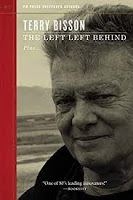While I prefer reading paper books, the heft and feel in the hand irreplaceable, it's inevitable that in 2022 ebooks and audiobooks are likewise present in my life. If I do consume the digital side of literature, I prefer short length—10 hour audiobooks, novellas, and collections are my go-to. Seeing a short collection by Terry Bisson on the cheap in e-form, I snapped it up. The book is Left, Left Behind plus... (2009).
When I said short, I meant short. Left, Left Behind plus... is two short stories sandwiched by a solid introduction and an in-depth interview with Bisson. That's it. It's a sampler of the personal variety. Despite this, it still offers more substance than a lot of the genre fluff making its way to shops.
The collection's title story is a sharp stiletto reminiscent of James Morrow's satire. Pricking the illogic of Christianity/Judaism, then effortlessly slicing the rapture head to toe, “Left Left Behind” tells of a rag-tag group of people not good enough for Jesus when he returns to Earth for his herd. It goes without saying the religiously sensitive should avoid this story. Then again, the religiously sensitive are likely not reading Bisson. For the rest of us, this is laugh-out-loud funny stuff with a salient moral impasse at its core. Line after line Bisson delivers a story that keeps the reader engaged for the characters, specifically their actions/behaviors and how they compare and contrast to “holy”, and the religious sub-text Bisson is clearly toying with.
Technically a play-script rather than short story, “Special Relativity” nevertheless has an arc. Where “Left Left Behind” is a bright splash of commentary and color, “Special Relativity” is a more delicate bit of satire. Set entirely in the backyard of a group of activists in the 2000s having a grill, the politicized youth, however, give center stage to three dead grandpas sitting in lawn chairs: Albert Einstein, Paul Robeson, and J. Edgar Hoover. Bisson clearly smirking as he plays with the stereotypes of the three characters, how they interact with the would-be protesters as things escalate in the background is sublime.
The third big section of the book is a chunky interview with Bisson. Covering his life from start to present, and from writing inspirations to politics, Bisson proves the American south has a voice in politics and religion that extends beyond stereotypes. It goes without saying readers interested in Bisson as a person benefit most from this.
If it wasn't clear, Left, Left Behind plus... would be of best value for two kinds of readers: 1) major fans who are looking for something personal regarding the author; the introduction and interviews form a good portion of the book, as short as it is, and 2) potential readers of Bisson who like to know something personal of their authors while sampling his fiction in two short stories.

No comments:
Post a Comment